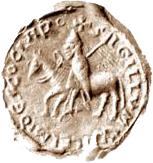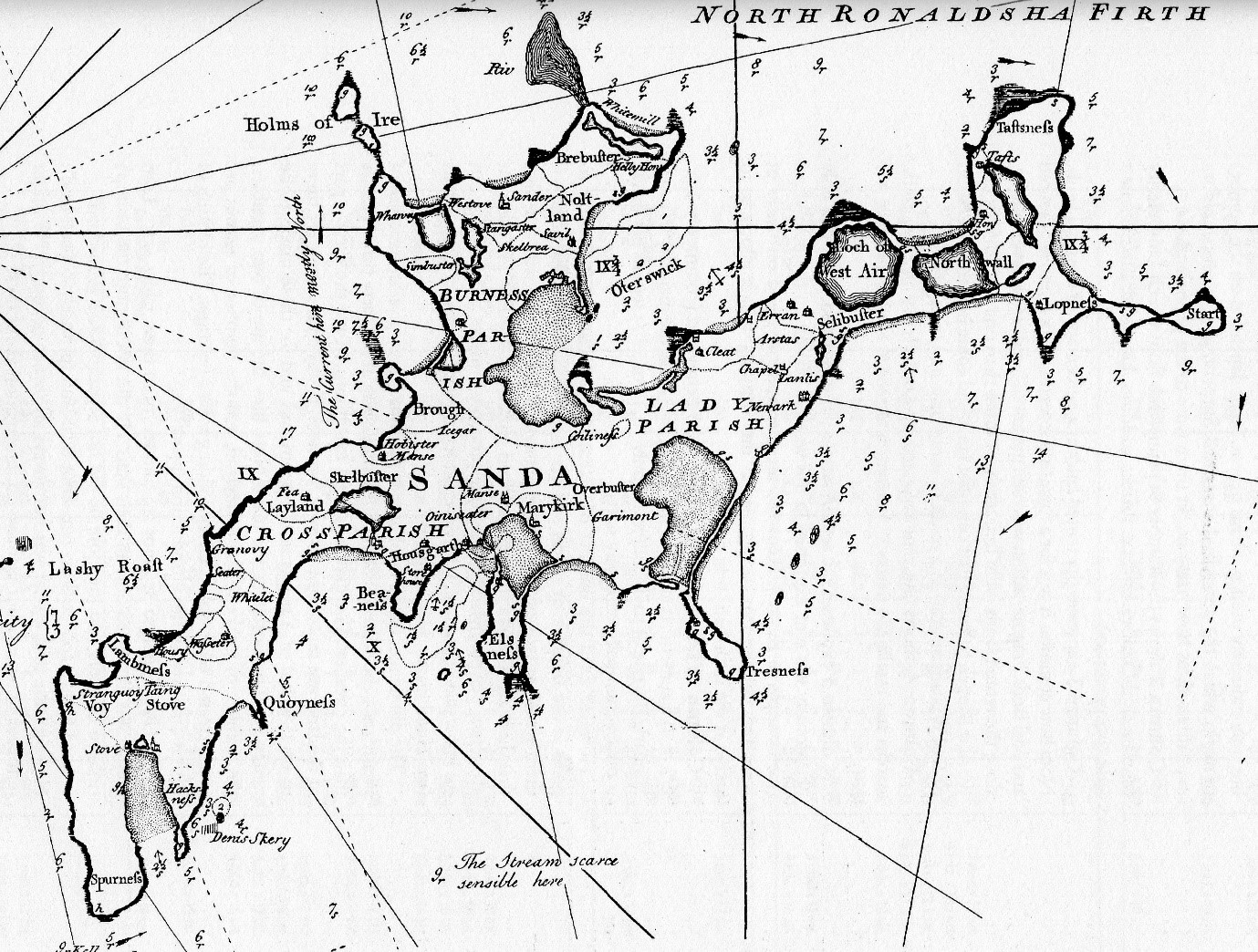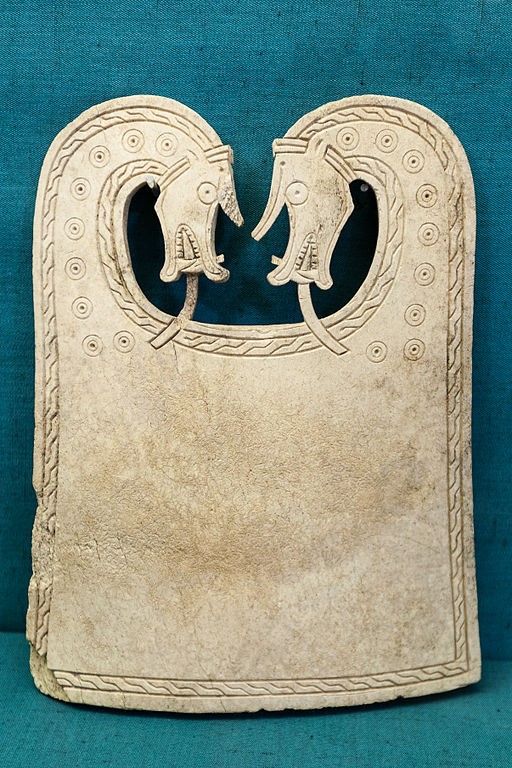Sinclair of Warsetter
Warsetter is a large farm near the highest point on the island of Sanday in Orkney, 300 feet above sea level, a place where beacons would be lit to warn of enemies approaching in Norse times. It was one of several properties acquired by Earl William Sinclair when, having the foresight to realise he was about to lose the Orkney earldom to King James III, he set about acquiring land either through ‘escheat’ (confiscation for non-payment of tax) or land transfer, or outright purchase. It became known as ‘conquest’ land and being personally owned or ‘udal’ land, it was excluded when Earl William’s comital title and its jurisdictions were ceded to King James in 1471, in exchange for Ravenscraig Castle and land surrounding it in Fife.
In his Lord Henry Sinclair’s 1492 Rental of Orkney, William P. Thomson estimated that Earl William acquired around 45% of the island of Sanday, plus large areas of land in Walls, and Holm and Paplay parishes on the mainland, as well as smaller land holdings in almost every other island, totalling around 31% of all the privately owned land in Orkney.
Earl William’s grandson, Lord Henry (son of William ‘the Waster’), acquired his first sub-tack of Orkney and Shetland around 1484 from the Bishop of Orkney and then held the tack in his own name from 1489. Lord Henry’s brother, Sir William of Warsetter, held land on several islands and acted as Justice during Henry’s absences in mainland Scotland. Sir William also had a close working relationship with his uncle, Sir David of Sumburgh, who by 1488 had been appointed the Foud or Sheriff of Shetland, and who in his will, left Sir William his ‘doublet of cloth of gold and my grey satin gown with three ostrich feathers’.
Sir William’s main landholding was Warsetter, but he also held the Bu of Brough and probably Tofts, Walls and Lopness on Sanday. On Westray, he held Rapness and Tuquoy, on Stronsay he held the bordland (old Norwegian earldom farmland), he held Newark in Deerness, and he also bought the udal lands of Tolhope or Toab in St Andrews parish from Nicol Fraser in 1514. Incidentally, the 1595 Rental of Cross parish, Sanday mentions ‘a tumale (land enclosed and tilled) with the Erles house’ at Hobbister and Fea in Cross parish – unfortunately long since disappeared. Whether it was built by one of the Sinclairs or the earlier Norwegian Yarls, we will probably never know.
Sir William had several illegitimate children, although he married Helen, probably the daughter of George Gordon, 2nd Earl of Huntly in Aberdeenshire, the High Chancellor of Scotland and his third wife, Lady Elizabeth Hay. Helen would have been born after her parents’ marriage in 1476. Sir William would have been somewhat older, born in the early 1460s and he had died before 13 May 1527, by which time his widow had married a David Hepburn, perhaps a family connection through her brother in law’s wife, Margaret Hepburn.
Their son, Magnus, became heir to his father’s lands. Not much is known about him although he was involved in the battle of Summerdale in 1529 and ten years later, he was one of thirty Orkney and Shetland men who were given a 19 year’s respite for their involvement in the death of his cousin, John Sinclair, the Earl of Caithness. By 8 August 1546 Magnus had died and his eldest son, William, was recognised as his heir.
In the following years, William was dealing with the indebted estate and began selling off some udal land; in 1547, William sold a house in Kirkwall to John Hartside (tacksman of the Bishop of Orkney); in 1550 he sold the lands of Essinquoy, Gramesetter and Clett on the mainland to his uncle, Edward Sinclair of Strom, which included restitution for 100 marks he had already borrowed from Edward to repay his father’s debts and for paying off his father’s other sister, Margaret. Tankerness and Quoy Bewmont in St Andrew’s parish had already been given to the Groats – his aunt Agatha had married William Groat, burgess of Kirkwall, from Duncansby in Caithness, and that land became her inheritance from her father’s estate. In 1575, William is mentioned as one of many other Orcadian landowners (many of them fellow Sinclairs), complaining to Parliament that Robert Stewart, the Earl of Orkney, had forcibly tried to make all the udallers give up their lands, and in William’s case, imprisoning him in Kirkwall Castle for some time. He survived but died sometime before 1586.
William’s heir was his eldest daughter Agnes, who by 6 February 1586 was already married to Henry Sinclair of Tuquoy [1] and was arranging a transfer of lands with her cousin, Malcolm Groat of Tankerness, in Graemsay and Wideford in St Ola parish on the mainland, in exchange for the remaining 23 years left to run on the tacks of the lands of Waldibreck and Garth [on the Warsetter estate] and Lambiness in Cross parish, Sanday. Henry of Tuquoy and Warsetter was one of many Orkney magnates caught up in the turmoil of Patrick Stewart, the Earl of Orkney’s divisive tenure of the earldom of Orkney and in 1592, along with representatives of several other Sinclair families, as well as all the other udallers in Orkney and Shetland, made a plea to Parliament complaining that Earl Patrick was forcibly trying to illegally steal their lands just as his father had tried to do. In 1597, trouble flared again, and the Privy Council imposed a ‘band’ on the major landholders of Orkney and Shetland whereby each landholder was to provide security assessed at varying levels, and Henry of Tuquoy had to find £1000 to keep the peace. Henry was still alive in September 1614 when he was part of a jury prosecuting the rebels during the siege of Kirkwall Castle by the Earl of Caithness and probably died shortly thereafter.
The next Sinclair of Warsetter bursts into the records in a court held at the castle of Kirkwall on 5 May 1615 where he was being tried on a charge of riot. He was accused of the ‘cruell and unmercifull unbesetting of Jon Broun, merchant in Bea in Sanday’, with ‘foirthort fellonie with swordis, pistollis and utheris weapons, invasive of purpose to have bereft him of his life, upone the third day of Apryle last.’ William denied the charge, but the assize decreed he was guilty, and the judge declared him an outlaw. William had been borrowing money over the span of several years, and the estate was still encumbered with debt, so this was probably a dispute about rent for the lands of Bea in Cross parish, Sanday.
William had married Alesone Sinclair, daughter of William Sinclair of Eday and Janet Halcro, and they had at least three sons. William had a very litigious time of it over the next few years; in May 1615, William was sued by his father-in-law, and eight years later, in July 1623, William sued his father-in-law, along with Eday’s brother John, so family relationships must have been tense! William was then sued by Gilbert Fea and John Colville of Huip, most likely over another business transaction. In September 1621, William had a charter drawn up giving Alesone the liferent of the lands of Holland and Bea in Sanday, providing her with an income in her old age and Edward, William’s eldest son, was given his inheritance in 1623 by his father. It seems likely given William’s debt problems he tried to protect his estate by giving his eldest son Edward his inheritance just before he died in about 1626. Edward had presumably died by 1636 when the next brother, George, became heir to his grandfather Henry’s lands.
Eventually, in January 1631, the tack of lands was given to John Stewart, Earl of Carrick, including the whole island of Eday, and everything in Sanday and Westray ‘which pertained to William Sinclair of Warsetter.’ What became of the Warsetter descendants is unknown; they may have stayed on whatever udal land they held as crofters, or they may have left the hard life in cold, famine-stricken Orkney and spread their wings further afield. However, in 1634 a Henry Sinclair, ‘merchant in Sanday’ bought several small parcels of land in Overbister, Lady parish, Sanday, from Helen Thomson and by 1649 is designed as ‘Henrie Sinclair in Beafield’ and was the baillie in Overbuster. It could just be that Henry was a Warsetter who had been named after his grandfather – it is tempting to think so, but there is just no conclusive proof.
Nina Cawthorne
Notes
[1] There is a possibility that Agnes’ husband, Henry Sinclair of Tuquoy, was the eldest, though illegitimate son of Robert Sinclair of Ness, a son of Edward Sinclair of Strom, which would mean Agnes and Henry were second cousins, sharing a great-grandfather. On 9 November 1576, Henry Sinclair, natural son of Robert Sinclair of Ness, obtained letters of legitimation from the King: ‘if the said Henry should die without legitimate heirs of his body, Patrick, legitimate son of his father Robert would be the heir of the said Henry.’ [Letters of legitimization only confer the right to bequeath any property they acquire to their descendants and Henry and Agnes had legitimate offspring]. The second piece of evidence is that in 1586, Robert Sinclair of Ness gave the lands of Campston to ‘his second son’ Robert, when ‘Henry Sinclair of Warsetter’ was the second witness, showing the family connection.
DESCENDANT TABLE
Henry, Lord Sinclair ( -1513) m. Margaret, dau. of Adam Hepburn, Master of Hailes, and Helen Home
Sir William Sinclair of Warsetter (Orkney) ( -1523/7) m. Elene Gordon, (?) dau. of Sir George Gordon, 2nd Earl of Huntly and Elizabeth Hay
Margaret Sinclair ( -aft.1550)
Sir James Sinclair of Brecks [legitimised 1536] ( -1536) m. Barbara, dau. of Andrew Stewart, 1st Lord Avondale and Margaret Kennedy, dau. of John, Lord Kennedy
Henry Sinclair [legitimised 1536]
Margaret Sinclair ( -aft.1584) m.(1) James Tulloch, portioner of Lambholm (Orkney) m.(2) Magnus Halcro of Brugh (Rousay), Precentor of St Magnus Cathedral, Kirkwall
Janet Halcro ( -aft.1630) m.(1) c.1579 René Elphinstone of Hammiger (Stromness)
Barbara Elphinstone (c.1580-aft.1623) m. J. Pearson of Newcastle, England
Robert Elphinstone of Hammiger (c.1582-1628) m.(1) Elizabeth Smyth
Alesone Sinclair of Eday ( -aft.1624) m. c.1610 William Sinclair of Warsetter ( -c.1626)
Elspeth Sinclair of Eday ( -bef.1624)
John Sinclair of Tolhope [ancestor of Sinclair of Tolhope] ( -bef.1568) m. unknown
Magnus Sinclair of Warsetter ( -1546) m. Janet Keith, ‘of that ilk’
William Sinclair of Warsetter (c.1530-bef.1586) m. unknown
Agnes Sinclair of Warsetter ( -aft.1623) m. bef.1586 Henry Sinclair of Tuquoy (Westray) ( -bef. 5 May 1615)
George Sinclair of Warsetter ( -aft.1636) [heir to his grandfather Henry in 1636]
William Sinclair ( -aft.1636)



